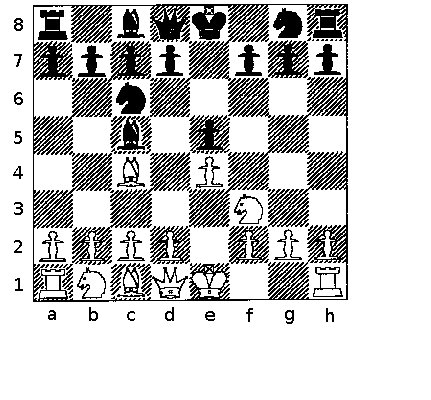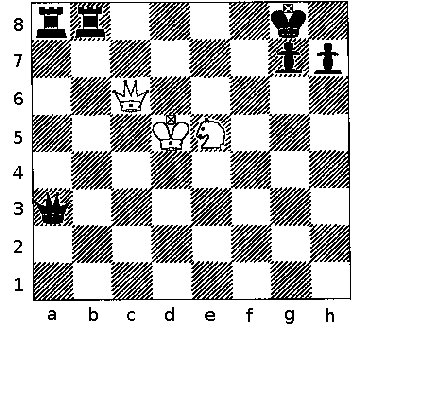Download
How to Read Chess Notation
Here's a very brief explanation of how to read algebraic and descriptive notation.
The board must always be set up so a white square is in the right hand corner.
This is very important and the game must start over if the board is set up wrong. I knew a master who once walked past a friend's tournament game and noticed that a black square was in the right hand corner. The game was declared invalid and a new game begun. The master came by again during the new game and put his thumbs to his head and wiggled his fingers, making donkey ears at his friend, who had been winning the first game but now was getting whomped. This unfortunate leaped up from the board with a roar, grabbed the master by the throat, and tried to strangle him.
The queen starts on a square of its own color.
In algebraic notation each square has a name, and that name is used by both White and Black.
Diagram 7

| 1. | e4 | e5 |
| 2. | Nf3 | Nc6 |
| 3. | Bc4 | Bc5 |
Moves
The ranks are numbered 1 - 8 and the files are labeled a - h. The square a1 is White's left corner square.
The name of the piece moved (except for pawns) is combined with the destination square. If there could be any confusion, add more information like the square, the rank, or the file where the piece came from. The P (for pawn) is not usually included.
1. White's pawn has moved from e2 to e4. It could be written e2 - e4, but if there can't be any confusion about which pawn is moving, pawn moves are usually shortened to just the destination square, here e4. Black's pawn has moved from e7 to e5.
2. White's knight has moved from g1 to f3. It could be written Ng1 - f3, but if there can't be any confusion about which piece is moving, piece moves are also shortened to just the piece and the destination square, here f3. Black's knight has moved from b8 to c6.
3. White's bishop has moved from f1 to c4 Black's bishop has moved from f8 to c5.
Captures
Piece captures in algebraic notation are usually written using the initials of the pieces and an " x " between them. Example: a rook capturing a knight which is on square e5 could be written as R x N or R x e5 or R x N(e5). Some players write Re5 just as if the rook had simply moved to e5.
Pawn captures are usually described by the file the capturing pawn is on and the file the captured pawn is on. Example: a pawn on e4 capturing a pawn on d5 is usually written as ed (shorthand for e x d which itself is shorthand for e4 x d5). If the pawn is capturing en passant, add ep. Example: a pawn on e5 capturing the d pawn en passant is written ed ep.
Descriptive Notation
I write my own games in descriptive notation. I've done it so long it's like breathing. Older books use descriptive and there's no prescriptive against it, which leaves critics seething.
Diagram 8

| 1. | P-K4 | P-K4 |
| 2. | N-KB3 | N-QB3 |
| 3. | B-B4 | B-B4 |
The rook on the queen's side is the queen's rook and the rook on the king's side is the king's rook. The knights and bishops are named the same way.
The files are named after the pieces which start the game on them (the queen's rook file, the king's bishop file, etc.) .
The pawns are named for the the file they are on (queen's knight pawn, king's pawn, king rook's pawn, etc.)
The king starts the game on his own first rank. Pawns start out on their own second rank. Pawns queen when they reach their own eighth rank.
In descriptive notation each square has two names which depend on the player who is moving. For example, when white is moving a knight from white's KN1 to white's KB3, both players write the move down as N-KB3 (written as Nf3 in algebraic.)
When black is moving a knight from black's QN1 to black's QB3, both players write the move down as N-QB3 (written Nc6 in algebraic).
Another way of saying this is that both players write each move as if the player writing down the move were sitting in the chair of the player making the move. From white's chair, black's queen starts out on white's eighth rank. From black's chair, white's queen starts out on black's eighth rank. Example: white's bishop on white's Q4 square (d4 in algebraic) captures black's pawn on black's KN2 square (g7 in algebraic). This is written B x P (if there are no other pawn captures that a bishop could make).
Some special moves:
- ep means en passant, in passing
- + means check
- ++ is sometimes used to mean checkmate
- 0-0 means king side castling
- 0-0-0 means queen side castling
Here are a few things which trip up beginners.
En passant captures. If your pawn is on your fifth rank and your opponent's pawn on the next file over moves up two squares instead of one, your pawn can capture it en passant (in passing) just as if it had moved up one square. If you want to capture en passant, you must do it immediately. You can't make some other move and then come back later and try to take it ep.
When castling, the king moves two squares over, regardless of whether he's going to the king side or the queen side. When castling king side, white's king ends up on g1. When castling queen side white's king ends up on c1.
You should castle as soon as you can, usually on the king's side, especially when you are still learning the game.
You can not castle if your king has already moved, even if he comes back to his original square. You can not castle if the rook with which you want to castle has already moved, even if it comes back to its original square. You can not castle if you are in check or if your opponent controls any of the squares your king would need to pass through, or which he would end up on (or "on which he up would end" if Winston Churchill were writing this). In other words, you can't castle if you are in check, passing through check, or into check.
For Practice Write down the moves in algebraic and descriptive notation.
White has a forced checkmate in five moves. An experienced player can spot this mate from miles away. See "Tactics" for other common examples.
Diagram 9

| Algebraic | Descriptive | |||||
| 1. | ______ | ______ | 1. | ______ | ______ | |
| 2. | ______ | ______ | 2. | ______ | ______ | |
| 3. | ______ | ______ | 3. | ______ | ______ | |
| 4. | ______ | ______ | 4. | ______ | ______ | |
| 5. | ______ | ______ | 5. | ______ | ______ |
If you haven't run across this before, it can be a real stinker. But if you enjoy seeing how white forces the mate, it's a very good sign for your future in chess.
Here are the moves. Algebraic first and then descriptive.
| 1. | Qe6+ | Kh8 |
| 2. | Nf7+ | Kg8 |
| 3. | Nh6 + | Kh8 |
| 4. | Qg8+ | R x Q |
| 5. | Nf7 | mate |
| 1. | Q-K6+ | K-R1 |
| 2. | N-B7+ | K-N1 |
| 3. | N-R6+ | K-R1 |
| 4. | Q-N8+ | R x Q |
| 5. | N-B7 | mate |
